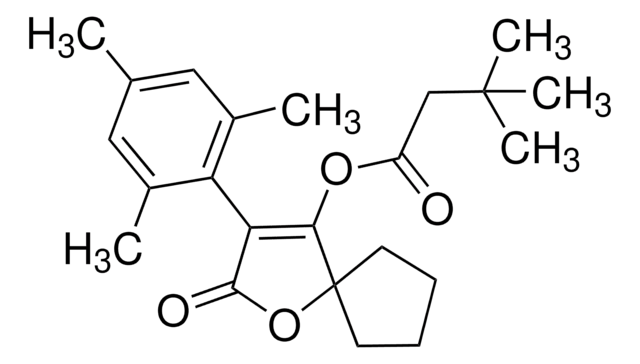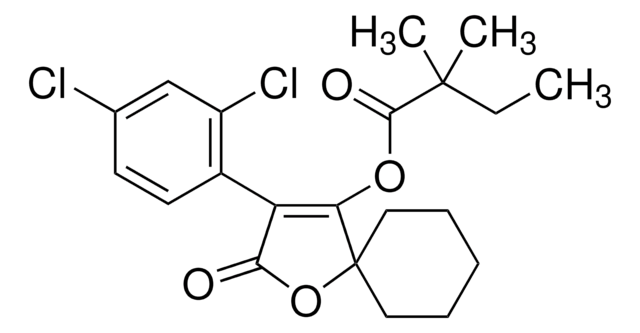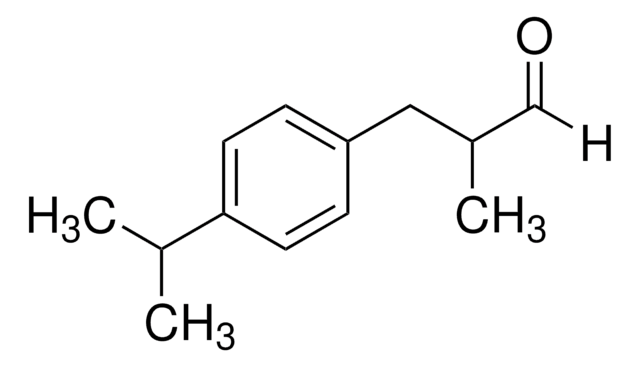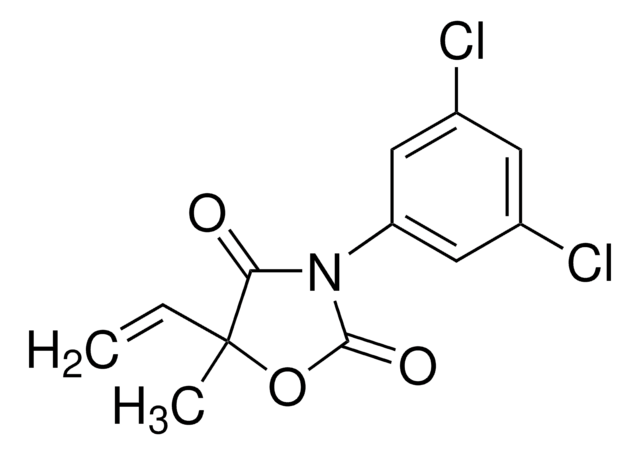推荐产品
等級
certified reference material
TraceCERT®
品質等級
產品線
TraceCERT®
形狀
powder
儲存期限
limited shelf life, expiry date on the label
製造商/商標名
Manufactured by: Sigma-Aldrich Production GmbH, Switzerland
SMILES 字串
CCC(C)(C)C(=O)OC1=C(C(=O)OC12CCCCC2)c3ccc(Cl)cc3Cl
InChI
1S/C21H24Cl2O4/c1-4-20(2,3)19(25)26-17-16(14-9-8-13(22)12-15(14)23)18(24)27-21(17)10-6-5-7-11-21/h8-9,12H,4-7,10-11H2,1-3H3
InChI 密鑰
DTDSAWVUFPGDMX-UHFFFAOYSA-N
正在寻找类似产品? 访问 产品对比指南
一般說明
This certified reference material (CRM) is produced and certified in accordance with ISO/IEC 17025 and ISO 17034. This CRM is traceable to primary material from an NMI, e.g. NIST or NMIJ. Certified content by quantitative NMR incl. uncertainty and expiry date are given on the certificate. Download your certificate at: http://www.sigma-aldrich.com.
Spirodiclofen is a selective, non-systemic acaricide belonging to the new family of spirocyclic tetronic acids (keto-enols). It is highly active against spider mites, such as Panonychus, Tetranychus, Phyllocoptruta, Brevipalpus, and Aculus species in citrus, pome fruits, grapes, and nuts. Spirodiclofen targets lipid biosynthesis by inhibiting acetyl-coenzyme A carboxylase (ACCase) and it effectively controls the population of mites resistant to other acaricides.
Spirodiclofen has to be monitored in the Multiannual Control Programmes for Pesticides Residues (MACP), run within the EU and EFTA in/on products of plant origin. Maximum residue levels (MRLs) have been set according to Reg (EG) No 2016/1902 for spirodiclofen for various products of plant and animal origin from 0.004 to 2 mg/kg.
Spirodiclofen was initially included in Annex I to Directive 91/414/EEC on 1 August 2010 and is approved under Regulation (EC) No 1107/2009, following Commission Implementing Regulation (EU) No 540/2011. However, after its approval expired on 31 July 2020, Spirodiclofen is no longer approved in the European Union (EU) but is authorized in third countries for use on citrus fruits that might be fed to livestock.
Spirodiclofen is a selective, non-systemic acaricide belonging to the new family of spirocyclic tetronic acids (keto-enols). It is highly active against spider mites, such as Panonychus, Tetranychus, Phyllocoptruta, Brevipalpus, and Aculus species in citrus, pome fruits, grapes, and nuts. Spirodiclofen targets lipid biosynthesis by inhibiting acetyl-coenzyme A carboxylase (ACCase) and it effectively controls the population of mites resistant to other acaricides.
Spirodiclofen has to be monitored in the Multiannual Control Programmes for Pesticides Residues (MACP), run within the EU and EFTA in/on products of plant origin. Maximum residue levels (MRLs) have been set according to Reg (EG) No 2016/1902 for spirodiclofen for various products of plant and animal origin from 0.004 to 2 mg/kg.
Spirodiclofen was initially included in Annex I to Directive 91/414/EEC on 1 August 2010 and is approved under Regulation (EC) No 1107/2009, following Commission Implementing Regulation (EU) No 540/2011. However, after its approval expired on 31 July 2020, Spirodiclofen is no longer approved in the European Union (EU) but is authorized in third countries for use on citrus fruits that might be fed to livestock.
應用
It is intended to be used as a certified reference material (CRM) for calibration in chromatography and other analytical techniques. Spirodiclofen CRM may also find its use as follows:
- Study the molecular mechanisms of spirodiclofen resistance using two highly resistant Tetranychus urticae strains with different genetic backgrounds
- To evaluate the sublethal effects of spirodiclofen, abamectin, and pyridaben on life-history traits and life-table parameters of two-spotted spider mites, Tetranychus urticae
- To evaluate the effect of a combination of spirodiclofen with other insecticides for the control of Brevipalpus yothersi in citrus
- Investigate the effects of salicylic acid treatment of tomato plants on the susceptibility of Tetranychus urticae to spirodiclofen, the activities of mite digestive enzymes, and its energy reserves
- Simultaneous determination of spirodiclofen, spiromesifen, and spirotetramat and their metabolites in edible fungi using a modified QuEChERS procedure and UHPLC-MS/MS
推薦產品
Find a digital Reference Material for this product available on our online platform ChemisTwin® for NMR. You can use this digital equivalent on ChemisTwin® for your sample identity confirmation and compound quantification (with digital external standard). An NMR spectrum of this substance can be viewed and an online comparison against your sample can be performed with a few mouseclicks. Learn more here and start your free trial.
法律資訊
TraceCERT is a registered trademark of Merck KGaA, Darmstadt, Germany
訊號詞
Danger
危險分類
Aquatic Chronic 1 - Carc. 1B - Repr. 2 - Skin Sens. 1B - STOT RE 2
儲存類別代碼
6.1C - Combustible acute toxic Cat.3 / toxic compounds or compounds which causing chronic effects
水污染物質分類(WGK)
WGK 2
閃點(°F)
Not applicable
閃點(°C)
Not applicable
Giulia Bellisai et al.
EFSA journal. European Food Safety Authority, 19(11), e06908-e06908 (2021-11-20)
According to Article 12 of Regulation (EC) No 396/2005, EFSA has reviewed the maximum residue levels (MRLs) currently established at European level for the pesticide active substance spirodiclofen. Although this active substance is no longer authorised within the European Union
Mohammad Homayoonzadeh et al.
Experimental & applied acarology, 82(3), 319-333 (2020-10-18)
Salicylic acid (SA) is a signaling molecule that can induce plant resistance to certain herbivores. Although the role of jasmonic acid in mediating mite-tomato plant interactions has been well studied, the role of salicylic acid has not. This study examined
Spirodiclofen and Spiromesifen
Nauen R, et al.
Pesticide Outlook, 243-246 null
Moosa Saber et al.
Experimental & applied acarology, 75(1), 55-67 (2018-03-10)
Two-spotted spider mite, Tetranychus urticae Koch, is one of the economically most important pests on a wide range of crops in greenhouses and orchards worldwide. Control of T. urticae has been largely based on the use of acaricides. Sublethal effects
Peter Demaeght et al.
Insect biochemistry and molecular biology, 43(6), 544-554 (2013-03-26)
Spirodiclofen is one of the most recently developed acaricides and belongs to the new family of spirocyclic tetronic acids (ketoenols). This new acaricidal family is an important chemical tool in resistance management strategies providing sustainable control of spider mites such
我们的科学家团队拥有各种研究领域经验,包括生命科学、材料科学、化学合成、色谱、分析及许多其他领域.
联系技术服务部门











